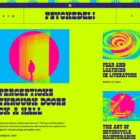
In the past couple of years, we’ve been seeing a rising trend in the web design industry which involved adding interactive 3D elements in websites.
While this trend allowed brands and businesses to create unique web experiences that helped them to stand out from the crowd, most of the time it was only utilized by big corporations. Mainly because creating 3D web experiences used to be limited, expensive, and, worst of all, they were very time-consuming.
Spline is a tool that aims to change that. Spline allows you to design and export functional 3D experiences for the web using a very simple and easy to use design tool.
In this post, we highlight what Spline can really do and how it will change the way you design websites in the near future.
Even though you’ve seen 3D objects and designs in video games and Hollywood movies, the whole concept of 3D web experiences was fairly new in the web design world. Until recently, with the introduction of WebGL technology, 3D design on the web was born.
If you’ve ever noticed a unique 3D and interactive element on the web, it’s most likely powered by the same technology. If you want to see it in action, take a look at the interactive 3D globe on the Stripe website, which visualizes Stripe’s global payments and treasury network in a very creative way.
A lot of work has gone into developing this interactive globe. Their team had to learn the complex ins and outs of WebGL and GLSL shaders as well as going through many failed experiments.
As you can glean from Stripe’s experience, designing 3D experiences for the web can be a daunting task. That’s part of the reason why web designers have been avoiding 3D design for all this time. Thankfully, things are changing for the better.
There are many different ways you can leverage 3D designs to create more unique websites. Many websites are already using it to their advantage. Here are just a few ways 3D web experiences are changing the standards of web design.
Helps Design Memorable Web Experiences
The main goal of every website is to create a memorable experience for visitors. You want to make sure that your potential customers and users remember your brand and the experience they’ve had while browsing the website.
This can be quite difficult when you are limited by the same old tools and technologies that you’ve been using for decades. And that’s exactly why 3D design provides a unique opportunity for you to create more memorable web experiences.
For example, the Netherland-based tire manufacturer Vredestein used 3D design to create a unique web experience for its customers, making even a boring topic such as tires fun to explore.
Improves User Interactions
Contrary to popular belief, when it comes to web design, looks mean everything. According to a survey conducted by the University of Surrey, people have admitted to forming 75% of their judgment of a website purely based on the website’s aesthetics.
However, a good looking website isn’t enough to win over your visitors. You also need to engage with them. And it can only be done by creating interactive web experiences.
With 3D designs, you can create more engaging content for your website where users can interact with 3D elements to explore more about products and services. That’s exactly what
The University of Southern Denmark did with its’ Future of Education website.
Create Realistic Product Previews
3D design can go a long way to showcase a product in a more realistic approach. Allowing customers to interact with the product to get a full 360-degree view can be a great way to convince them to push the “buy” button.
The product pages on the Boss atHome website is a great example that shows how it’s done. The site features 3D models of its products that users can interact with and even customize to their preferences.
Better Experiences in VR & AR
Ever since its acquisition of Oculus, Facebook has been working hard on the next generation of AR and VR technology. The company recently announced a new augmented reality smart glass to be released in 2021.

Whether you like it or not, AR and VR technologies are remaking the future. Soon, people will be browsing the web using their smart glasses instead of smartphones and laptops. And 3D web experiences will certainly take a major role in creating future-proof websites.
What Is Spline?
How exactly do you create these amazing 3D web experiences without having to spend months building them or having to spend thousands of dollars hiring web development agencies? This is where Spline comes to help.
Spline is a new 3D design tool that aims to make the whole process of creating 3D web experiences much easier. Using Spline, you’ll be able to create engaging 3D objects and content with interactive elements without having to deal with sophisticated coding and rendering.
How It Works
Spline features a very easy to use interface that’s quite similar to Photoshop or Illustrator. Using this editor, you get to create 3D content and export them directly in web format as JavaScript, HTML, and CSS.

You can use Spline to create 3D designs from scratch or import your 3D models rendered with other software as well. Everything you design using Spline can be exported as fully interactive experiences.

Basically, Spline allows you to design 3D web experiences just like how you design graphics using Photoshop. What normally takes weeks of development can be achieved in hours using Spline.
Needless to say, Spline will surely change the way you design 3D content for websites in a good way.
Conclusion
Spline is still in the works and currently giving early access to designers and developers who are willing to test it out and help improve its features. It’s worth checking this tool out if you’re interested in the future of web design.
3D design on the web is a trend that will soon spread all over the Internet. Especially thanks to tools like Spline. You can follow their social feeds on Twitter @splinetool and Instagram for the latest updates and previews.










